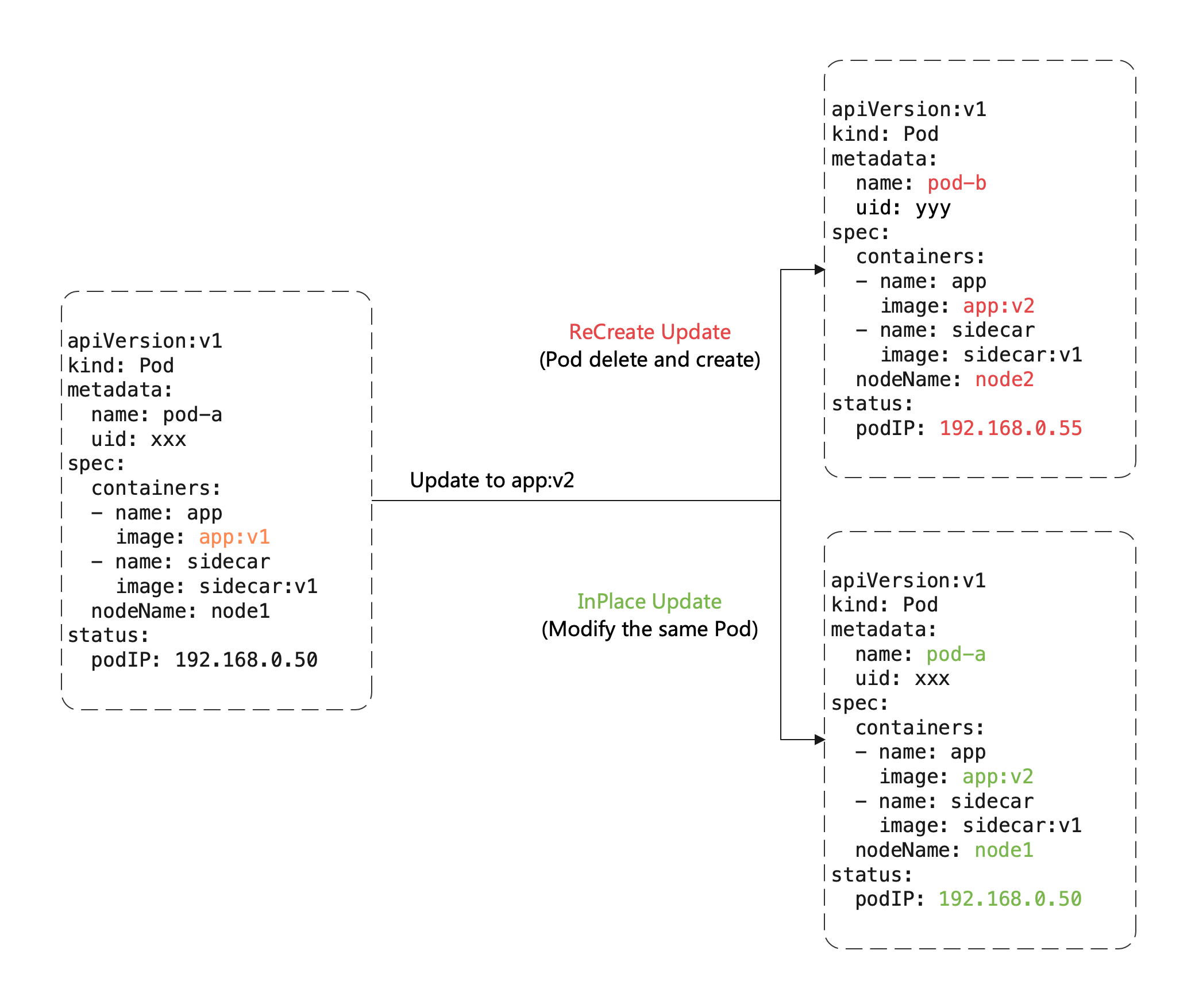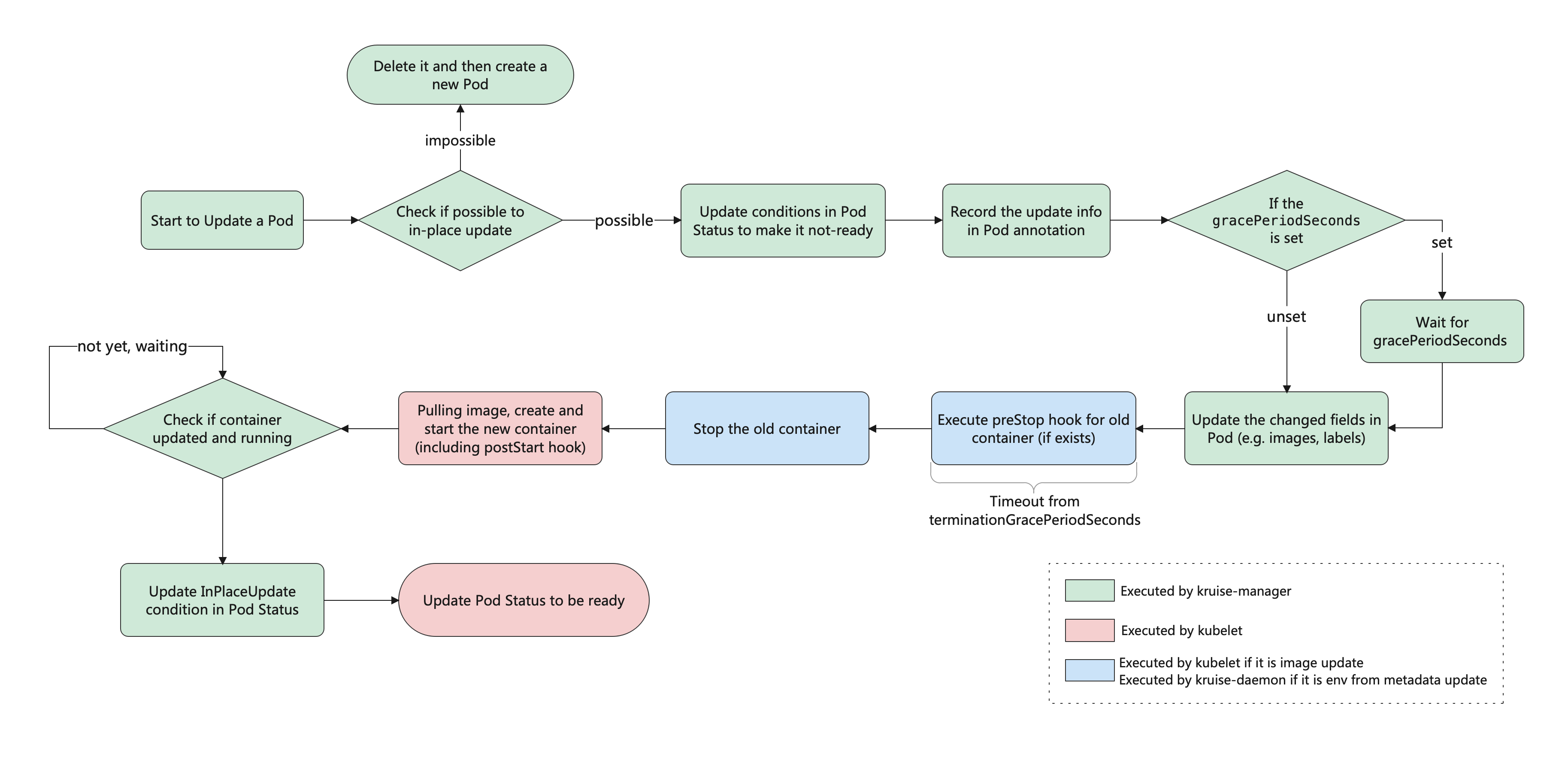InPlace Update
In-place Update is one of the key features provided by OpenKruise.
Workloads that support in-place update:
Currently CloneSet, Advanced StatefulSet and Advanced DaemonSet re-use the same code package ./pkg/util/inplaceupdate and have similar behaviours of in-place update. In this article, we would like to introduce the usage and workflow of them.
Note that the in-place update workflow of SidecarSet is a little different from the other workloads, such as it will not set Pod to not-ready before update. So the things we talk below do not totally go for SidecarSet.
What is in-place update?
Once we are going to update image in a existing Pod, look at the comparation between Recreate and InPlace Update:

In ReCreate way we have to delete the old Pod and create a new Pod:
- Pod name and uid all changed, because they are totally different Pod objects (such as Deployment update)
- Or Pod name may not change but uid changed, because they are still different Pod objects, although re-use the same name (such as StatefulSet update)
- Node name of the Pod changed, because the new Pod is almost impossible to be scheduled to the previous node.
- Pod IP changed, because the new Pod is almost impossible to be allocated the previous IP.
But for InPlace way we can re-use the Pod object but only modify the fields in it, so that:
- Avoid additional cost of scheduling, allocating IP, allocating and mounting volumes
- Faster image pulling, because of we can re-use most of image layers pulled by the old image and only to pull several new layers
- When a container is in-place updating, the other containers in Pod will not be affected and remain running.
Understand InPlaceIfPossible
The update type in Kruise workloads is named InPlaceIfPossible, which tells Kruise to update Pods in-place as possible, and it should go back to ReCreate Update if impossible.
What changes does it consider to be possible to in-place update?
- Update
spec.template.metadata.*in workloads, such as labels and annotations, Kruise will only update the metadata to existing Pods without recreate them. - Update
spec.template.spec.containers[x].imagein workloads, Kruise will in-place update the container image in Pods without recreate them. - Since Kruise v1.0 (including v1.0 alpha/beta), update
spec.template.metadata.labels/annotationsand there exists container env from the changed labels/annotations, Kruise will in-place update them to renew the env value in containers. - Since Kruise v1.8, if the Kubernetes cluster has
InPlacePodVerticalScalingenabled and the KruiseInPlaceWorkloadVerticalScalingfeature is also enabled, updatingspec.template.spec.containers[x].resourceswill trigger Kruise to perform an in-place update of these container resources without recreate them.
Otherwise, the changes to other fields such as spec.template.spec.containers[x].env or spec.template.spec.containers[x].resources(if the Kruise InPlaceWorkloadVerticalScaling feature is disabled) will go back to ReCreate Update.
Take the CloneSet YAML below as an example:
- Modify
app-image:v1image, will trigger in-place update. - Modify the value of
app-configin annotations, will trigger in-place update (Read the Requirements below). - Modify the two fields above together, will tigger in-place update both image and environment.
- Directly modify the value of
APP_NAMEin env or add a new env, will trigger recreate update.
apiVersion: apps.kruise.io/v1alpha1
kind: CloneSet
metadata:
...
spec:
replicas: 1
template:
metadata:
annotations:
app-config: "... the real env value ..."
spec:
containers:
- name: app
image: app-image:v1
env:
- name: APP_CONFIG
valueFrom:
fieldRef:
fieldPath: metadata.annotations['app-config']
- name: APP_NAME
value: xxx
updateStrategy:
type: InPlaceIfPossible
Workflow overview
You can see the whole workflow of in-place update below (you may need to right click and open it in a new tab):

InPlace update with launch priorities
FEATURE STATE: Kruise v1.1.0
When you in-place update multiple containers at once and the containers have different launch priorities, Kruise will update the containers by order according to the priorities.
- For pods without container launch priorities, no guarantees of the execution order during in-place update multiple containers.
- For pods with container launch priorities:
- keep execution order during in-place update multiple containers with different priorities.
- no guarantees of the execution order during in-place update multiple containers with the same priority.
For example, we have the CloneSet that includes two containers with different priorities:
apiVersion: apps.kruise.io/v1alpha1
kind: CloneSet
metadata:
...
spec:
replicas: 1
template:
metadata:
annotations:
app-config: "... config v1 ..."
spec:
containers:
- name: sidecar
env:
- name: KRUISE_CONTAINER_PRIORITY
value: "10"
- name: APP_CONFIG
valueFrom:
fieldRef:
fieldPath: metadata.annotations['app-config']
- name: main
image: main-image:v1
updateStrategy:
type: InPlaceIfPossible
When we update the CloneSet to change app-config annotation and image of main container, which means both sidecar and main containers need to update,
Kruise will firstly in-place update pods that recreates sidecar container with the new env from annotation.
At this moment, we can find the apps.kruise.io/inplace-update-state annotation in updated Pod and see its value:
{
"revision": "{CLONESET_NAME}-{HASH}", // the target revision name of this in-place update
"updateTimestamp": "2022-03-22T09:06:55Z", // the start time of this whole update
"nextContainerImages": {"main": "main-image:v2"}, // the next containers that should update images
// "nextContainerRefMetadata": {...}, // the next containers that should update env from annotations/labels
"preCheckBeforeNext": {"containersRequiredReady": ["sidecar"]}, // the pre-check must be satisfied before the next containers can update
"containerBatchesRecord":[
{"timestamp":"2022-03-22T09:06:55Z","containers":["sidecar"]} // the first batch of containers that have updated (it just means the spec of containers has updated, such as images in pod.spec.container or annotaions/labels, but dosn't mean the real containers on node have been updated completely)
]
}
When the sidecar container has been updated successfully, Kruise will update the next main container. Finally, you will find the apps.kruise.io/inplace-update-state annotation looks like:
{
"revision": "{CLONESET_NAME}-{HASH}",
"updateTimestamp": "2022-03-22T09:06:55Z",
"lastContainerStatuses":{"main":{"imageID":"THE IMAGE ID OF OLD MAIN CONTAINER"}},
"containerBatchesRecord":[
{"timestamp":"2022-03-22T09:06:55Z","containers":["sidecar"]},
{"timestamp":"2022-03-22T09:07:20Z","containers":["main"]}
]
}
Usually, users only have to care about the containerBatchesRecord to make sure the containers are updated in different batches. If the Pod is blocking during in-place update, you should check the nextContainerImages/nextContainerRefMetadata and see if the previous containers in preCheckBeforeNext have been updated successfully and ready.
Requirements
To use InPlace Update for env from metadata, you have to enable kruise-daemon (defaults to be enabled) and InPlaceUpdateEnvFromMetadata feature-gate when install or upgrade Kruise chart.
Note that if you have some nodes of virtual-kubelet type, kruise-daemon may not work on them and in-place update for env from metadata will not be executed.
In-Place Update Support for Modifying Resources
FEATURE STATE: Kruise v1.8.0
If you have enabled InPlaceWorkloadVerticalScaling during Kruise installation or upgrade,
Kruise Advanced Workloads support modifying container resources (CPU/Memory) during in-place updates.
This feature allows users to directly update the following fields without triggering Pod recreation:
apiVersion: apps.kruise.io/v1alpha1
kind: CloneSet
spec:
#...
template:
spec:
containers:
- name: <container-name>
resources:
requests:
cpu: "2" # Can be modified
memory: "2Gi" # Can be modified
limits:
cpu: "4" # Can be modified
memory: "4Gi" # Can be modified
Notes
-
This feature requires the Kubernetes cluster to have the
InPlacePodVerticalScalingfeature-gate enabled. Ensure your cluster supports this capability. For more information, refer to the Kubernetes documentation. -
Cgroupv1 Limitations:
- In a Cgroupv1 environment, modifying both image and resource fields simultaneously is prohibited (e.g., updating both the image and CPU quota at the same time). The operation must be performed in two steps:
- First, complete the in-place update for resource modifications.
- Then, trigger an in-place update for image changes.
- For more details, see the community Issue #127356.
- Resource Type Restrictions:
- Only modifications to
cpuandmemoryfields withinrequestsandlimitsare supported. - Other resource types (e.g., GPU) will trigger Pod recreation.
- Modifications to resources must not alter the Pod's QoS. If the Pod's QoS changes, it will trigger Pod recreation.